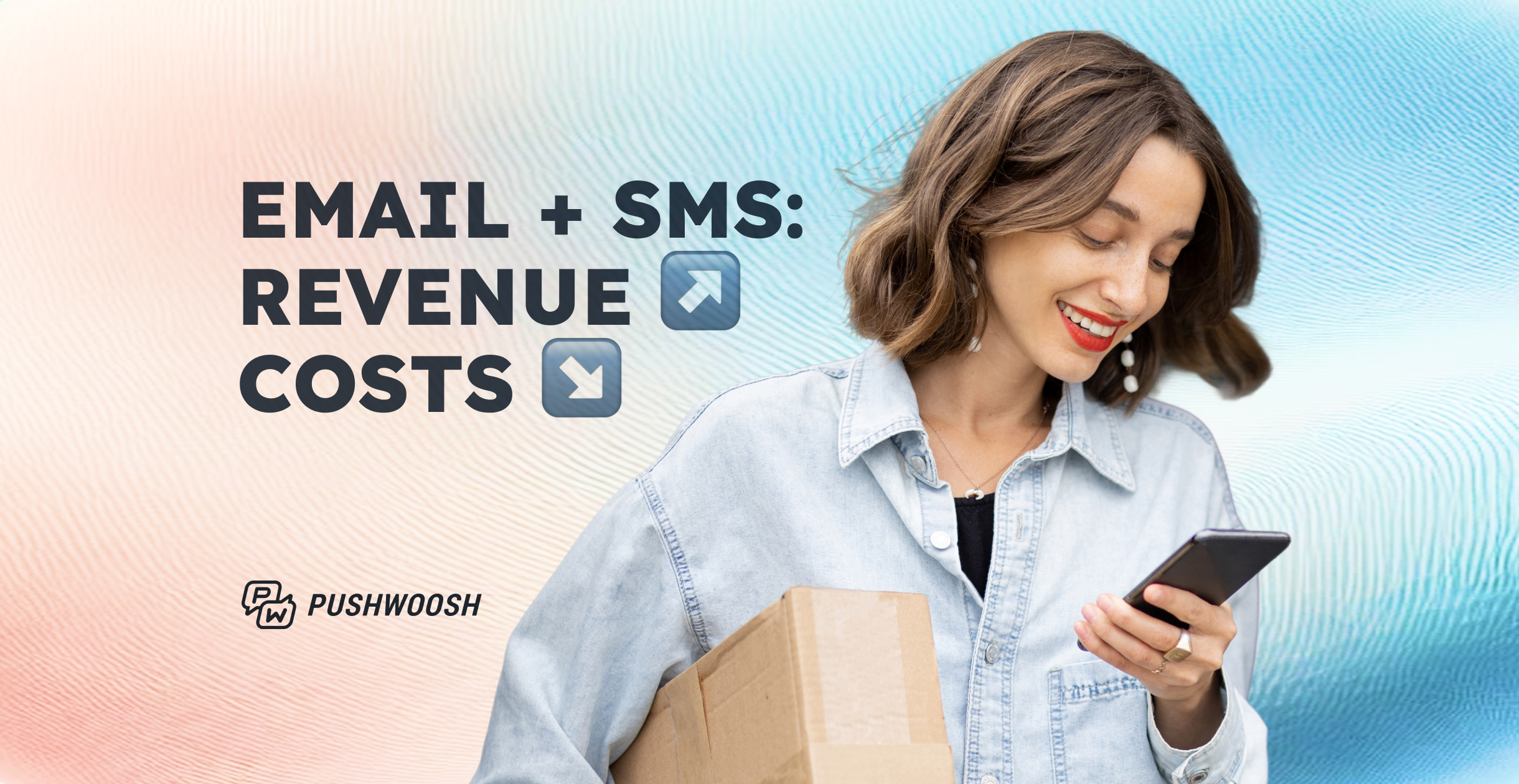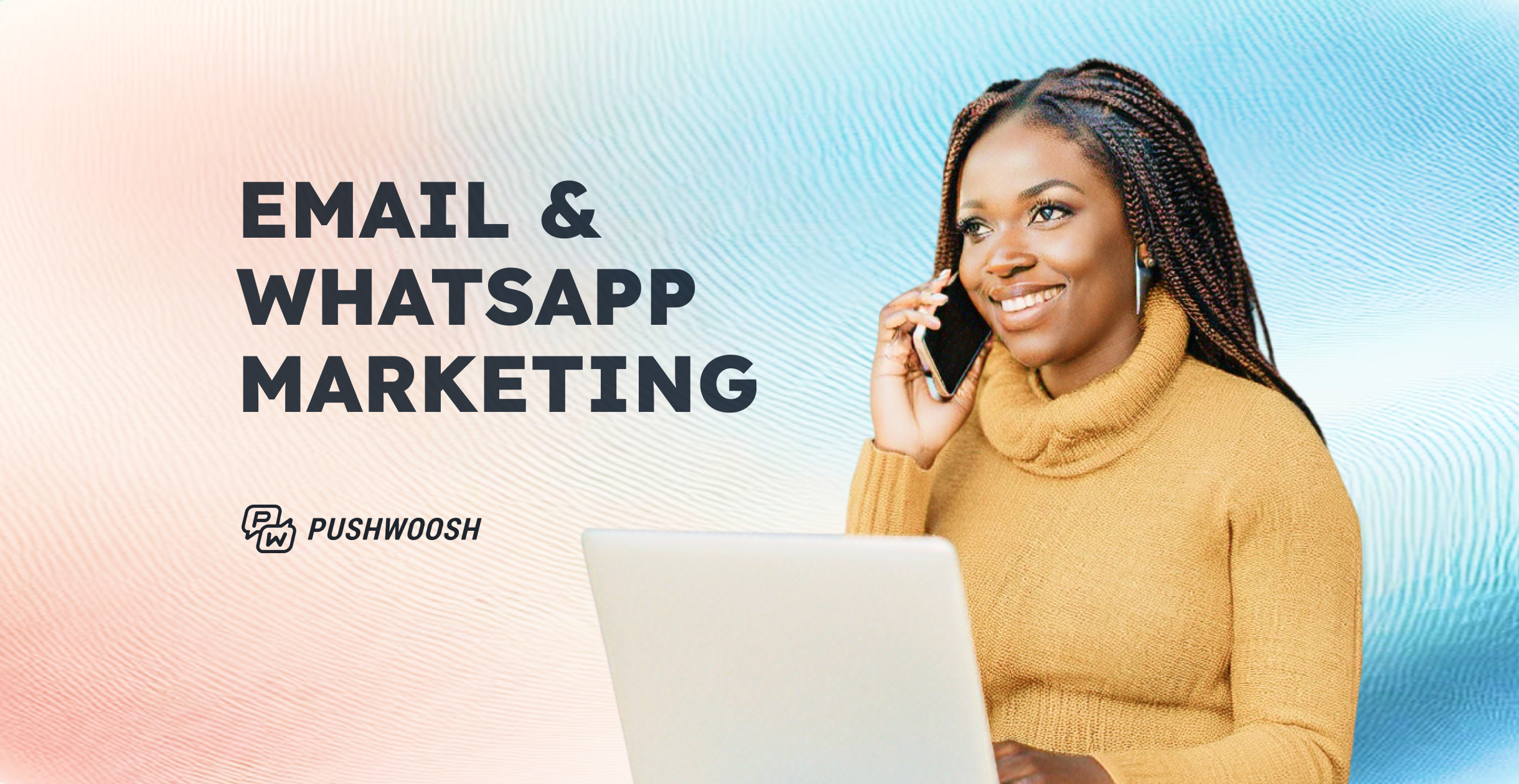Email and SMS marketing: How to scale engagement without burning budgets
If your mobile app already sends email and SMS messages, you’re ahead of the game—but not immune to growing pains. For B2C apps with large user bases, even well-established communication channels like email and SMS can become:
- Hard to manage as audiences grow and messaging workflows get more complex
- Costly to run, especially when SMS usage ramps up
- Fragmented, with email managed in one platform and SMS in another
This hurts your ROI and overwhelms your team.
The fix? Orchestrate email, SMS, and other relevant channels in one platform like Pushwoosh. Scale your messaging without increasing the costs or team workload.
Let’s break down what’s typically going wrong and how to set it up for success.
Why email and SMS campaigns underperform in mobile apps
1. Disconnected tools = messy logic
Using one platform for email, another for SMS, and a third for push creates silos. There’s no shared segmentation, no unified triggers, and no way to coordinate your messaging logic across channels.
2. Overlapping sends = frustrated users
Without orchestration, the same user might get both an email and an SMS about the same offer, often some minutes apart. That’s not just inefficient; it’s annoying. This leads to unsubscribes (in the best scenario) and gets you flagged as spam, hurting your domain rating (in the worst case).
3. No fallback = missed opportunities
If you can’t reach your user via their preferred channel (e.g., SMS), and there is no workflow setup to trigger as a backup channel (e.g., email or push notifications), you’re leaving engagement (and revenue) on the table.
4. No real insight into what drives conversions = poor resource allocation
When campaigns live in different systems, there’s no central reporting. You might see opens and clicks, but not the full customer journey and its impact on ROI. As a result, you may often end up paying for the tools and channels that don’t benefit your business in any significant way.
5. More time spent on tool management = busier dev teams
Integrating, syncing, and maintaining different ESPs and SMS APIs costs dev hours. Man-hours are better spent building features, not fixing workflows, after all. By managing all the channels from a single platform, you significantly reduce the workload.
If any of this sounds familiar, it’s time to rethink your setup!
What actually works: Real-life use cases for scalable engagement
Leveraging email and SMS communications in a single workflow can help you significantly boost your performance and save precious time on campaign setup.
Email is the most cost-effective channel, with an average ROI of 3600%. SMS, in turn, comes through like no other when it comes to time-sensitive communications, with 90% of SMS messages read in the first three minutes upon delivery.
Play to the strengths of each to maximize your campaign’s reach.
Here are some helpful industry-specific scenarios for you to learn from:
🏦 Fintech apps
In fintech, it is crucial to be able to quickly verify user actions, like sign-ups, transactions, or account changes. Delivering these types of messages in a convenient and reliable way is not just a matter of building trust. It’s essential to meet regulatory requirements and reduce fraud by ensuring sensitive actions are authenticated through a reliable communication channel.
That’s why having a steady fallback option for all transactional communications is a must.
Say a user signs up and needs to verify their identity.
→ Send a confirmation email first.
→ If unopened, within two minutes, send an SMS notification.
This way, you try to reach the user via their preferred (and/or more cost-effective) channel. But if, for whatever reason, they are unable to interact with it at the moment, you still give them an opportunity to complete the goal.
How to do it with Pushwoosh:
You don’t need to be a developer to build advanced automation with Pushwoosh! Customer Journey Builder allows setting up conditions like “if [email] not opened, then send [SMS]. An automated cross-channel communications workflow like this can be built in seconds:

🎮 Game apps
In the gaming industry, it’s all about building user retention without spending a fortune on communications. Here, the effectiveness of your email and SMS marketing campaigns can be increased by adding a third channel, like push notifications and in-app messages.
For example, if you want to announce a new in-game event with maximum reach and minimum cost:
→ Send a push notification or an in-app message to all players featuring the event’s detailed overview.
→ Based on their in-app behavior, identify the most active, VIP players, and notify them personally via email. Since they are already highly engaged with your game, they are less likely to miss the update! → Based on their in-app behavior, identify the most active, VIP players, and notify them personally via email. Since they are already highly engaged with your game, they are less likely to miss the update!
→ Follow up with an SMS to the VIPs who haven’t launched the game within the first three hours to re-engage these high-value users.

🛍️ E-Commerce or delivery apps
Promotions are at the heart of all e-commerce communications. But sometimes, a single email is just not enough.
If, for example, you’re launching a flash sale on a limited-time deal, missing that one email may cause a customer to lose a valuable discount. So, why not try a cross-channel approach instead?
→ Send an email and a push notification to your full segment, personalizing the copy of your message: a push can speak of urgency, while an email may cover more details of the promo offer.
You can choose the best channel based on pre-determined user preferences.
→ If a user hasn’t interacted with any of these communications within 30 minutes, send them an SMS with a limited-time deal.
📰 News & media apps with subscription-based monetization
Email is commonly used to remind users their next payment cycle, but an additional channel may be as effective in reducing churn.
→ First, send a reminder email one month in advance, giving the user some time to prepare. In the email, you can also explain the benefits of renewal or justify the price change, if that’s the case.
→ One week before the new billing cycle, send an in-app notification to active users, making sure the charge won’t be sudden.
→ And in case the payment fails on the day of the renewal, turn to SMS for urgent actions.
🧾 Retail applications
To successfully grow your retail revenue, you need to invest in customer loyalty and communicate with audience segments based on their levels:
→ New users: Onboard them via in-app messages and emails to illustrate all the benefits your business brings to the table.
→ Loyal customers: Engage them via cost-effective push notifications that you can afford to send regularly to maintain interest in your brand.
→ Users at risk of churn: Take urgent action with personalized SMS offers.
How to do it with Pushwoosh:
You can easily identify core user segments based on engagement thanks to Pushwoosh’s RFM segmentation and tailor your communications strategy accordingly.

How to optimize costs without hurting engagement
1. Use SMS only when it matters
SMS is more expensive than other marketing channels, so use it only when you absolutely have to: for transactional alerts, confirmations, or time-sensitive promos.
SMS also makes an excellent fallback option for delivering urgent communications when a recipient doesn’t have internet access, for example.
2. Prefer push to SMS when possible
Push notifications are more affordable and, at times, less intrusive than SMS. They can be used for both transactional and marketing communications.
3. Prioritize low-cost channels but enable fallback
It’s always better to stick to less costly channels, like push or email, for most of your communications, but it’s crucial to have an effective fallback strategy in place.
SMS has a higher open rate than push and can be delivered even when the user doesn’t have internet access, making it a perfect fallback option for critical communications.
4. Measure what matters
Don’t just track opens—look at conversions, retention, and LTV impact to track your campaign’s effectiveness. Analyze engagement rates to identify users at risk of churn early and take action. Learn which channels resonate with which audience the most and optimize your campaigns effectively.
Pushwoosh Dashboards provide a complete picture of your campaigns and app performance, while other features, like A/B/n testing, allow for close-up analytics and optimization.
When it’s time to rethink your email & SMS setup
If you’re using SMS and email already, but the results are not there, here are a couple of things that could go wrong:
- You’re using separate ESP and SMS platforms, forced to stitch things together manually
- You can’t track campaign performance in one place
- You’re not sure which messages (or channels) actually drive conversions
- Campaign setup eats up your dev team’s time
- You’re missing SLAs or critical user actions due to poor fallback logic
If any of this rings true, it’s not a messaging problem—it’s a platform problem.
How to choose the best platform for your SMS and email campaigns
Scaling engagement isn’t about choosing between email and SMS. It’s about coordinating them intelligently, efficiently, and with your users in mind. That’s exactly what Pushwoosh is for!
So, if you want to elevate your users’ mobile app experience and:
- Build smart, automated journeys
- Orchestrate multiple channels in one platform
- Save dev time and reduce messaging costs
- Understand what really drives user action




